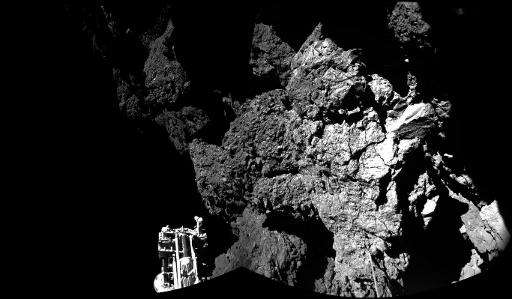An image taken by Rosetta's Philae on comet 67P/Churyumov-Gerasimenko shows part of the lander, in a photo released by the European Space Agency (ESA) on November 13, 2014
Europe's robot lab Philae, zipping towards the Sun on a comet, has called home for the eighth time since waking up from hibernation last month, French space agency CNES said Friday.
After a 15-day silence, Philae had a 20-minute conversation with ground control via its mother ship Rosetta, in orbit around comet 67P/Churyumov-Gerasimenko, it said in a statement.
This was "very encouraging news for the remainder of the Philae mission," the agency said.
There had been no news from the washing machine-sized robot lab since June 24, a disquieting break for mission controllers.
Philae first woke up on June 13 after seven months in hibernation on the comet's surface.
The tiny lander touched down on November 12 last year after a 10-year journey piggybacking on Rosetta.
The landing was bumpy—the tiny lab bounced several times on the craggy surface before ending up in deep shade, deprived of sunlight to replenish its battery.
Philae had enough onboard power to send home data from about 60 hours of tests conducted with eight of its 10 instruments, before going into standby mode on November 15.
But the lander's power pack is being recharged as 67P streaks toward the Sun at about 31 kilometres (19 miles) per second.
Thursday's eighth contact was the longest yet, with an uninterrupted stretch of 12 minutes, said the CNES, which allowed the downloading of critical data obtained from Philae's prodding and probing of its alien world.
"The link was by far the best yet, with very few interruptions," said the statement.
"It bodes well for the future because such a good connection would allow the teams to take control of Philae and give it commands"—possibly to shift position or start its drill for a sub-surface examination.
Philae is equipped with ten instruments, with which its creators hope to learn more about the properties of comets and their possible role in bringing life to Earth.
Comets are frozen balls of dust, ice and gas left over from the Solar System's formation some 4.6 billion years ago.
Some experts believe that comets smashed into our infant planet, providing it with precious water and the chemical building blocks for life.
Comet 67P is approaching perihelion—its closest point to the Sun at about 185 million km (115 million miles)—on August 13, and scientists are excited about getting a first-hand view of the dramatic change it will go through as it sheds more and more material.
© 2015 AFP
























